Click image for BBB rating
See our Privacy Policy
Welcome to Spaightwood Galleries, Inc.
120 Main Street, Upton MA 01568-6193
You can follow us on Facebook and Twitter!
Biblical Subjects
Mythological Subjects
Allegorical Subjects
Historical Subjects
Adam and Eve
Noah
Lot and his Daughters
Joseph
Samson
Jephthah and his Daughter
David
Judith
Esther
Susanna and the Elders
De Vos Old Testament Women 1
De Vos Old Testament Women 2
De Vos New Testament Women
The Virgin Mary
Mary Magdalen
The Woman taken in adultery
The Crucifixion
The Lamentation
The Resurrection
North Italian Illuminated Manuscript
Italian Old Master Drawings: An Overview
Italian School, 16th-Century Drawings
Michelangelo Buonarotti (After)
Raphael
Giulio Romano
Perino del Vaga
Marcantonio Raimondi
Parmigianino
Titian (after)
Andrea Schiavone
Tintoretto
Veronese
Taddeo Zuccaro
Federico Zuccaro
Alessandro Casolani
Jacopo Palma il Giovane
Cherubino Alberti
Luca Cambiaso
Annibale Carracci
Ludovico Carracci
Italian School, 17th-Century Drawings
Bolognese School
Giovanni Baglione
Matteo Rosselli
Ercole Bazzicaluva
Baldassare Franceschini called Il Volterrano
Pier Francesco Mazzuccelli, il Morazzone
Odoardo Fialetti
Simone Cantarini
Domenichino
Francesco Albani
Giovanni Lanfranco
Guercino
Pier Francesco Mola
Antonio Busca
Italian School Printmakers, 15th-17th Centuries: Venetian School, c. 1497
Raphael School
Giovanni Jacopo Caraglio
Marcantonio Raimondi
The Master of the Die
Anea Vico
Agostino Veneziano
Nicholas Beatrizet
Michelangelo Buonarotti (After)
Giulio Bonasone
Giovanni Battista Franco
Girolamo Fagiuoli
Cherubino Alberti
Titian (after)
Tintoretto (after)
Parmigianino
Giorgio Ghisi
Diana Scultori
Annibale Carracci
Ludovico Carracci
Agostino Carracci
Simone Cantarini
Elisabetta Sirani
Gerolamo Scarsello
Netherlandish School, 15th-17th-Century Drawings
Flemish School, 17th-Century
Bernaert van Orley
Lucas van Leyden
Maarten de Vos
Jan Baptiste de Wael
Abraham Bloemaert
Peter Paul Rubens
Philipp Sadeler
Nicolaes Maes
Rembrandt School
Netherlandish Printmakers 16th-17th Centuries: Lucas van Leyden
Maarten van Heemskerck
Cornelis Cort
Philips Galle
Abraham de Bruyn
Hans (Jan) Collaert
Adriaen Collaert
Karel de Mallery
Theodore Galle
Hendrik Goltzius
Julius Goltzius
Jacob Matham
Jan Sanraedam
Maarten de Vos
Jan Sadeler
Aegidius Sadeler
Raphael Sadeler
Crispin de Passe
Magdalena de Passe
Wierix Brothers
Rembrandt,
Rembrandt School
Jan Lievens
Jan Joris van Vliet
Ferdinand Bol
Govert Flinck
German Drawings: Hans Sebald Beham
Virgil Solis / Hans von Aachen
Joseph Heinrich Roos
German 16th century printmakers: Heinrich Aldegrever
Jost Amman
Hans Sebald Beham,
Hans Brosamer
Hans Burgkmair
Lucas Cranach
Albrecht Durer
Albrecht Durer (After)
Hans Holbein (After)
Hopfer Brothers
Georg Pencz
Hans Schäufelein
Virgil Solis, Wolfgang Stuber
French Drawings: Charles de La Fosse
Etienne Parrocel
François Boucher
Jean-François de Neufforge
Mouricault
French printmakers: Etienne Delaunne
Rene Boyvin
Thomas de Leu
Jean Cousin the Younger
Jacques Callot
Abraham Bosse
Sebastien Bourdon
Claude Gelle "le Lorraine"
Jean LePautre
Claudine Bouzonnet Stella
Antonette Bouzonnet Stella
Gabriel Perelle
In his preface to his Commentary on the Book of Psalms (1557), John Calvin suggests the place that David and his Psalms held in the imagination of learned Renaissance readers of Psalms and collectors of art: "I have been accustomed to call this book, I think not inappropriately, 'An Anatomy of all the Parts of the Soul,' for there is not an emotion of which any one can be conscious that is not here represented as in a mirror. Or rather the Holy Spirit has here drawn to the life all the griefs, sorrows, fears, doubts, hopes, cares, perplexities, in short, all the distracting emotions with which the minds of men are wont to be agitated. . . . [H]ere the prophets themselves, seeing that they are exhibited to us as speaking to God, and laying all their inmost thoughts and affections, call, or rather draw, each of us to the imagination of himself in particular, in order that none of the many infirmities to which we are subject, and of the many vices with which we abound, may remain concealed. It is certainly a rare and singular advantage, when all lurking places are discovered, and the heart is brought into the light, purged from that most baneful infection, hypocrisy" (John Calvin: Selections from His Writings, ed. John Dillenberger (NY: Doubleday, 1971), p. 23). David is the perfect everyman because, as John Lyly puts it in the opening pages of his Euphues: The Anatomy of Wit (1578), "In all perfect works as well the fault as the face is to be shown": and exemplifies this paradox with the figures of David and his son Solomon:"Solomon wise yet too too wanton. David holy, but yet an homicide" (Paul Salzman, ed. An Anthology of Elizabethan Prose Fiction [NY: Oxford University press, 1987], pages 85 and 89), exemplifying what Lyly says is the truth of the natural condition: "As therefore the sweetest rose hath his prickle, the finest velvet his brack, the fairest flower his bran, so the sharpest wit hath his wanton will, and the holiest head his wicked way." Solomon's wisdom, the gift granted him by God, cannot prevent him from building temples for the pagan gods of his wives surrounding the temple he builds for the God of Israel and David, annointed by Samuel at God's direction as His choice for the crown, His chosen one to succeed Saul as King after Saul proves more afraid of displeasing the people than willing to fulfill God's rather explicit directions for what He wants done (see 1 Samuel 15: 10-35; 1 Kings 15: 10-35 in a Protestant Bible), despite his love for God, cannot keep himself from allowing his love for Bathsheba to lead him to adultery and murder.
In the works that folow, we present a set of 10 engravings executed c. 1556 after drawings by Maerten van Heemskerck, one of the leading Netherlandish artists of the later 16th century and one whose inventions proved invaluable to such printmakers as Philips Galle, who frequently worked from Heemskerck's drawings. In this case, although we do not know the identity of the engraver, plate 1 of the set identifies Heemskerk as the inventor and Joan Galle as the publisher. It is rare to find a complete set of such works in any condition; these are in very good condition and the plates are printing very strongly. The set tells a story, or at least a part of a story, but the story is not necessarily a narrative so much as it is an emblem of the way of all flesh.
For Heemskerck, see volumes 1 and 2 in the New Hollstein catalogues raisonnés of Dutch & Flemish Etchings, Engravings, and Woodcuts 1470-1700, compiled by Ilja M. Veldman, edited by Ger Luitjen, and published in 1993 and 1994 by Koninklijke van Poll (Roosendall) in 1973-1974 in cooperation with the Rijksprentkabinet at the Rijksmuseum (Amsterdam). Since many of the prints engraved by Philips Galle were also published by him and, after his death by the brothers Theodor and Johannes Galle, it is possible that these also were engraved by Philips Galle since the second and third states were published by the brothers.
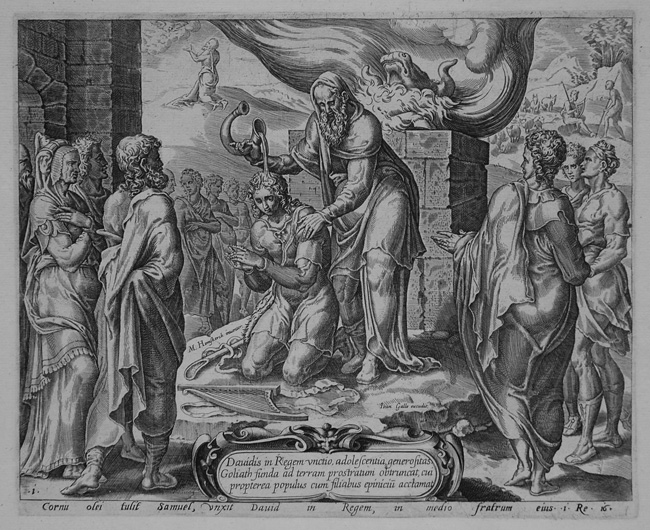
Maerten van Heemskerck (Antwerp, 1498-1574), after, Samuel anointing David (New Holl. 94 iii/iv). Plate 1 of a series of 10 engravings after Heemskerck's drawing, which is preserved in the Louvre and dated 1555. Originally published by Hieronymous Cock in 1556. After the death of his widow (c. 1601), it was published by Theodore Galle and then his brother, Johannes Galle. The final state was published, after some re-engraving, by Claes Jansz. Visscher in 1646. A rich impression printed on antique laid paper with large margins outside the platemark. The moment presented here derives from Samuel 16 Douay-Rheims or (1 Kings 16 in a Protestant translation): "And the Lord said to Samuel: 'Look not on his countenance, nor on the height of his stature: because I have rejected him, nor do I judge according to the look of man: for man seeth those things that appear, but the Lord beholdeth the heart' "; when David comes from the fields, we learn that "he was ruddy and beautiful to behold, and of a comely face. And the Lord said: 'Arise, and anoint him, for this is he.' Then Samuel took the horn of oil, and anointed him in the midst of his brethren: and the Spirit of the Lord came upon David from that day forward: and Samuel rose up, and went to Ramatha. But the Spirit of the Lord departed from Saul, and an evil spirit from the Lord troubled him." Image size: 205x253mm. Price: Please call or email for current pricing information.
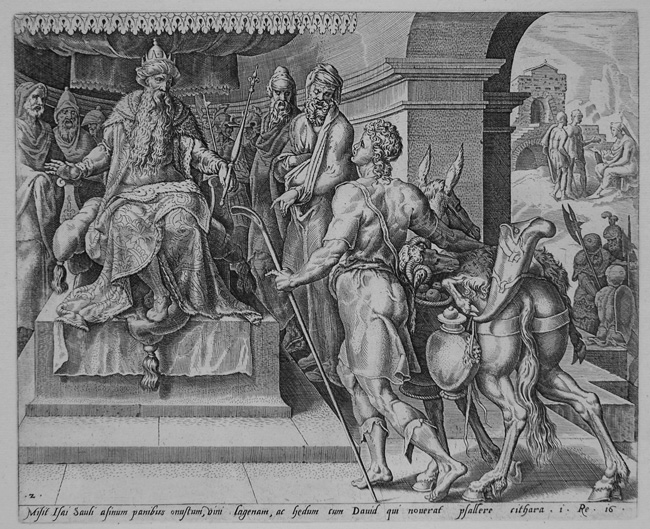
Maerten van Heemskerck (Antwerp, 1498-1574), after, David brings gifts for Saul from his father (New Holl. 95 iii/iv). Plate 2 of a series of 10 engravings after Heemskerck's drawing, which is preserved in the Louvre and dated 1555. Originally published by Hieronymous Cock in 1556. After the death of his widow (c. 1601), it was published by Theodore Galle and then his brother, Johannes Galle. The final state was published, after some re-engraving, by Claes Jansz. Visscher in 1646. A rich impression printed on antique laid paper with large margins outside the platemark. The moment presented here derives from Samuel 16 Douay-Rheims or (1 Kings 16 in a Protestant translation): "And the servants of Saul said to him: 'Behold now an evil spirit from God troubleth thee. Let our lord give orders, and thy servants who are before thee, will seek out a man skilful in playing on the harp, that when the evil spirit from the Lord is upon thee, he may play with his hand, and thou mayst bear it more easily.' And Saul said to his servants: 'Provide me then some man that can play well, and bring him to me.' And one of the servants answering, said: 'Behold I have seen a son of Isai [Jesse], the Bethlehemite, a skilful player, and one of great strength, and a man fit for war, and prudent in his words, and a comely person: and the Lord is with him.' Then Saul sent messengers to Isai, saying: 'Send me David, thy son, who is in the pastures.' And Isai took an ass laden with bread, and a bottle of wine, and a kid of the flock, and sent them by the hand of David, his son, to Saul. And David came to Saul, and stood before him: and he loved him exceedingly, and made him his armourbearer. And Saul sent to Isai, saying: 'Let David stand before me: for he hath found favour in my sight.' So whensoever the evil spirit from the Lord was upon Saul, David took his harp, and played with his hand, and Saul was refreshed, and was better, for the evil spirit departed from him." Image size: 205x251mm. Price: Please call or email for current pricing information.
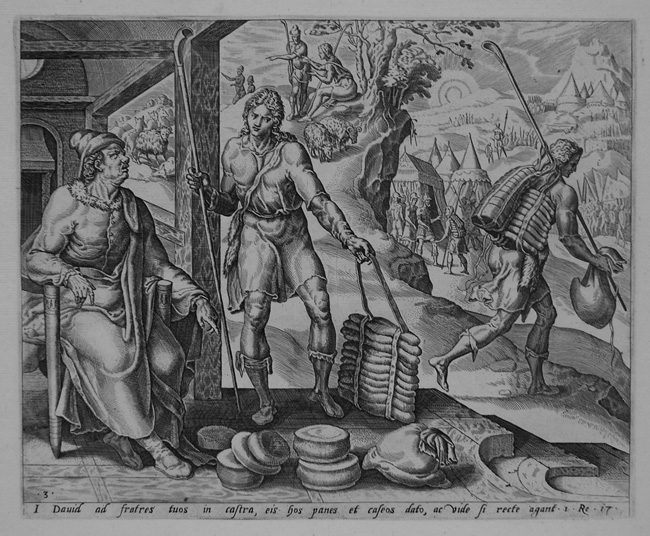
Maerten van Heemskerck (Antwerp, 1498-1574), after, Jesse sends David with gifts for his brothers (New Holl. 96 iii/iv). Plate 3 of a series of 10 engravings after Heemskerck's drawing, which is preserved in the Louvre and dated 1555. Originally published by Hieronymous Cock in 1556. After the death of his widow (c. 1601), it was published by Theodore Galle and then his brother, Johannes Galle. The final state was published, after some re-engraving, by Claes Jansz. Visscher in 1646. A rich impression printed on antique laid paper with large margins outside the platemark. The moment presented here derives from Samuel 17 Douay-Rheims or (1 Kings 17 in a Protestant translation): After Goliath makes his challenge to Israel, Saul and three of David's brothers go to where the army is gathered and David goes back to Jesse's home to take care of the sheep:"Now the Philistine came out morning and evening, and presented himself forty days. And Isai said to David, his son: 'Take for thy brethren an ephi of frumenty, and these ten loaves, and run to the camp to thy brethren, And carry these ten little cheeses to the tribune: and go see thy brethren, if they are well: and learn with whom they are placed.' But Saul, and they, and all the children of Israel, were in the valley of Terebinth, fighting against the Philistines. David, therefore, arose in the morning, and gave the charge of the flock to the keeper: and went away loaded, as Isai had commanded him. And he came to the place of Magala, and to the army, which was going out to fight, and shouted for the battle. For Israel had put themselves in array, and the Philistines who stood against them were prepared. And David leaving the vessels which he had brought, under the care of the keeper of the baggage, ran to the place of the battle, and asked if all things went well with his brethren. And as he talked with them, that baseborn man, whose name was Goliath, the Philistine, of Geth, showed himself coming up from the camp of the Philistines: and he spoke according to the same words, and David heard them, And all the Israelites, when they saw the man, fled from his face, fearing him exceedingly. And some one of Israel said: 'Have you seen this man that is come up, for he is come up to defy Israel. And the man that shall slay him, the king will enrich with great riches, and will give him his daughter, and will make his father's house free from tribute in Israel.' "Image size: 205x251mm. Price: Please call or email for current pricing information.
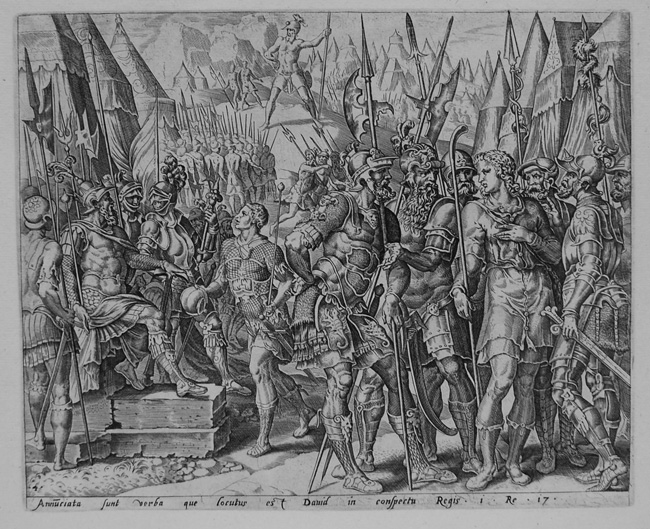
Maerten van Heemskerck (Antwerp, 1498-1574), after, David inquires about Goliath's challenge (New Holl. 97 iii/iv). Plate 4 of a series of 10 engravings after Heemskerck's drawing, which is preserved in the Louvre and dated 1555. Originally published by Hieronymous Cock in 1556. After the death of his widow (c. 1601), it was published by Theodore Galle and then his brother, Johannes Galle. The final state was published, after some re-engraving, by Claes Jansz. Visscher in 1646. A rich impression printed on antique laid paper with large margins outside the platemark. The moment presented here derives from Samuel 17: "And when he was brought to Saul, he said to him. 'Let not any man's heart be dismayed in him: I thy servant will go, and will fight against the Philistine.' And Saul said to David: 'Thou art not able to withstand this Philistine, nor to fight against him: for thou art but a boy, but he is a warrior from his youth.' And David said to Saul: 'Thy servant kept his father's sheep, and there came a lion, or a bear, and took a ram out of the midst of the flock: And I pursued after them, and struck them, and delivered it out of their mouth: and they rose up against me, and I caught them by the throat, and I strangled, and killed them. For I thy servant have killed both a lion and a bear: and this uncircumcised Philistine shall be also as one of them. I will go now, and take away the reproach of the people: for who is this uncircumcised Philistine, who hath dared to curse the army of the living God?' And David said: 'The Lord who delivered me out of the paw of the lion, and out of the paw of the bear, he will deliver me out of the hand of this Philistine.' " Image size: 205x251mm. Price: Please call or email for current pricing information.
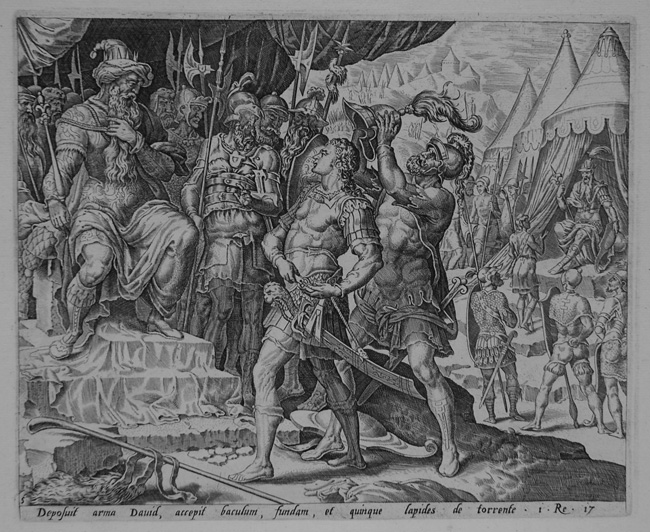
Maerten van Heemskerck (Antwerp, 1498-1574), after, David being armed before Saul (New Holl. 99 iii/iv). Plate 5 of a series of 10 engravings after Heemskerck's drawing, whereabouts unknown. Originally published by Hieronymous Cock in 1556. After the death of his widow (c. 1601), it was published by Theodore Galle and then his brother, Johannes Galle. The final state was published, after some re-engraving, by Claes Jansz. Visscher in 1646. A rich impression printed on antique laid paper with large margins outside the platemark. The moment presented here derives from Samuel 17: "And Saul said to David: 'Go, and the Lord be with thee.' And Saul clothed David with his garments, and put a helmet of brass upon his head, and armed him with a coat of mail." Image size: 206x253mm. Price: Please call or email for current pricing information.
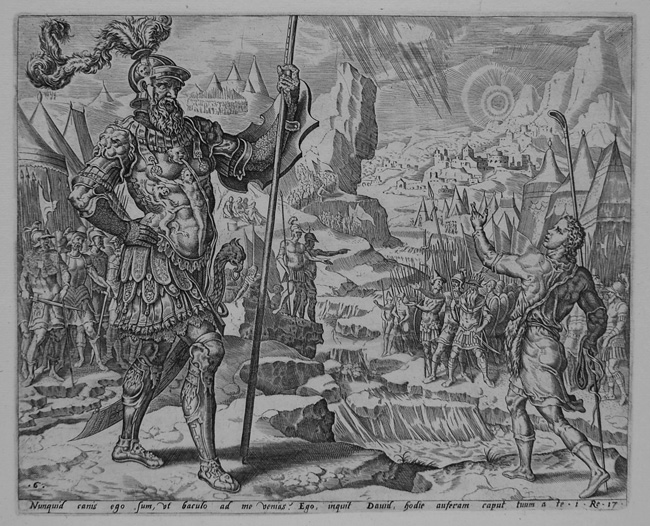
Maerten van Heemskerck (Antwerp, 1498-1574), after, David confronts Goliath (New Holl. 99 iii/iv). Plate 6 of a series of 10 engravings after Heemskerck's drawing, which is preserved in the Louvre and dated 1555. Originally published by Hieronymous Cock in 1556. After the death of his widow (c. 1601), it was published by Theodore Galle and then his brother, Johannes Galle. The final state was published, after some re-engraving, by Claes Jansz. Visscher in 1646. A rich impression printed on antique laid paper with large margins outside the platemark. The moment presented here derives from Samuel 17: "And David having girded his sword upon his armour, began to try if he could walk in armour: for he was not accustomed to it. And David said to Saul: 'I cannot go thus, for I am not used to it.' And he laid them off, and he took his staff, which he had always in his hands: and chose him five smooth stones out of the brook, and put them into the shepherd's scrip, which he had with him, and he took a sling in his hand, and went forth against the Philistine. the Philistine came on, and drew nigh against David, and his armourbearer went before him. And when the Philistine looked, and beheld David, he despised him. For he was a young man, ruddy, and of a comely countenance. And the Philistine said to David: 'Am I a dog, that thou comest to me with a staff?' And the Philistine cursed David by his gods. And he said to David: 'Come to me, and I will give thy flesh to the birds of the air, and to the beasts of the earth.' And David said to the Philistine: 'Thou comest to me with a sword, and with a spear, and with a shield: but I come to thee in the name of the Lord of hosts, the God of the armies of Israel, which thou hast defied this day, and the Lord will deliver thee into my hand, and I will slay thee, and take away thy head from thee: and I will give the carcasses of the army of the Philistines this day to the birds of the air, and to the beasts of the earth: that all the earth may know that there is a God in Israel. And all this assembly shall know that the Lord saveth not with sword and spear: for it is his battle, and he will deliver you into our hands.' And when the Philistine arose, and was coming, and drew nigh to meet David, David made haste, and ran to the fight to meet the Philistine. And he put his hand into his scrip, and took a stone, and cast it with the sling, and fetching it about, struck the Philistine in the forehead, and he fell on his face upon the earth. And David prevailed over the Philistine, with a sling and a stone, and he struck, and slew the Philistine. Image size: 204x253mm. Price: Please call or email for current pricing information.
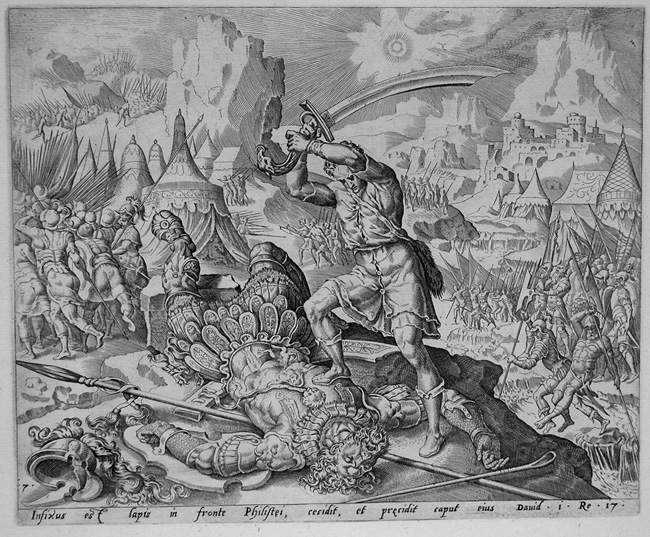
Maerten van Heemskerck (Antwerp, 1498-1574), after, David severs Goliath's head (New Holl. 100 iii/iv). Plate 7 of a series of 10 engravings after Heemskerck's drawing, which is preserved in the Louvre and dated 1555. Originally published by Hieronymous Cock in 1556. After the death of his widow (c. 1601), it was published by Theodore Galle and then his brother, Johannes Galle. The final state was published, after some re-engraving, by Claes Jansz. Visscher in 1646. A rich impression printed on antique laid paper with large margins outside the platemark. The moment presented here derives from Samuel 17: "And as David had no sword in his hand, He ran, and stood over the Philistine, and took his sword, and drew it out of the sheath, and slew him, and cut off his head. And the Philistines seeing that their champion was dead, fled away. And the men of Israel and Juda rising up shouted, and pursued after the Philistines till they came to the valley and to the gates of Accaron, and there fell many wounded of the Philistines in the way of Saraim, and as far as Geth, and as far as Accaron. And the children of Israel returning, after they had pursued the Philistines, fell upon their camp." Image size: 205x251mm. Price: Please call or email for current pricing information.
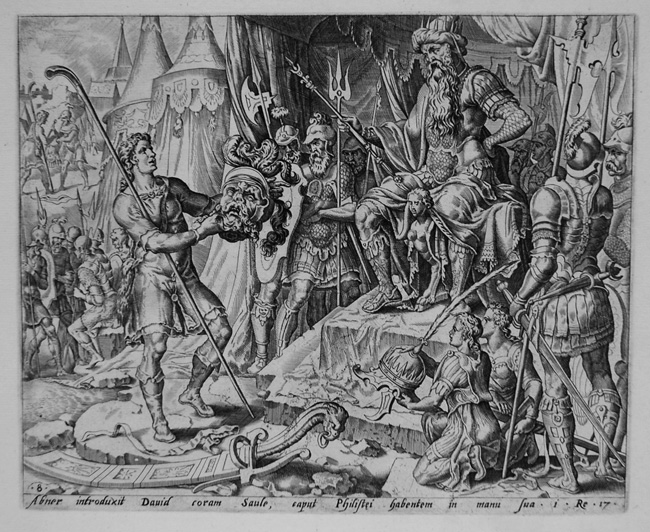
Maerten van Heemskerck (Antwerp, 1498-1574), after, Abner presents David with Goliath's head to Saul (New Holl. 101 iii/iv). Plate 8 of a series of 10 engravings after Heemskerck's drawing, whereabouts unknown. Originally published by Hieronymous Cock in 1556. After the death of his widow (c. 1601), it was published by Theodore Galle and then his brother, Johannes Galle. The final state was published, after some re-engraving, by Claes Jansz. Visscher in 1646. A rich impression printed on antique laid paper with large margins outside the platemark. The moment presented here derives from Samuel 17: "And David taking the head of the Philistine, brought it to Jerusalem: but his armour he put in his tent. Now at the time that Saul saw David going out against the Philistines, he said to Abner, the captain of the army: 'Of what family is this young man descended, Abner?' And Abner said: 'As thy soul liveth, O king, I know not.' And the king said: Inquire thou, whose son this young man is. When David was returned, after the Philistine was slain, Abner took him, and brought him in before Saul, with the head of the Philistine in his hand. And Saul said to him: 'Young man, of what family art thou?' And David said: 'I am the son of thy servant Isai the Bethlehemite.' "Image size: 205x253mm. Price: Please call or email for current pricing information.
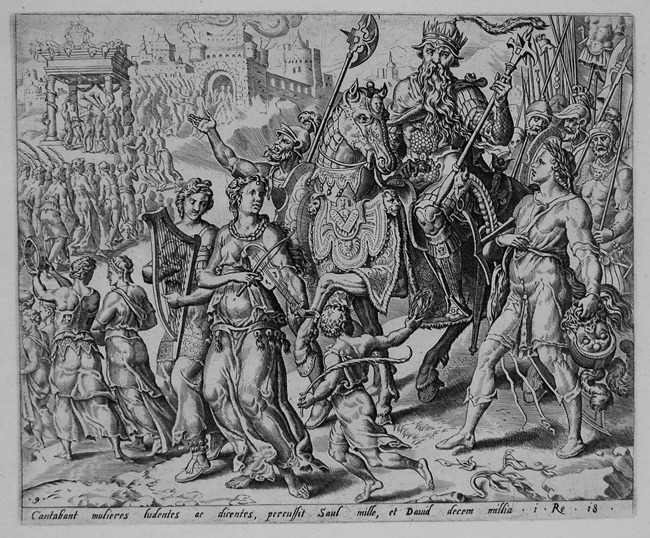
Maerten van Heemskerck (Antwerp, 1498-1574), after, David and Saul greeted by women celebrating (New Holl. 102 iii/iv). Plate 9 of a series of 10 engravings after Heemskerck's drawing, which is preserved in the Louvre and dated 1555. Originally published by Hieronymous Cock in 1556. After the death of his widow (c. 1601), it was published by Theodore Galle and then his brother, Johannes Galle. The final state was published, after some re-engraving, by Claes Jansz. Visscher in 1646. A rich impression printed on antique laid paper with large margins outside the platemark. The moment presented here derives from Samuel 18: "And David went out to whatsoever business Saul sent him, and he behaved himself prudently: and Saul set him over the soldiers, and he was acceptable in the eyes of all the people, and especially in the eyes of Saul's servants. Now when David returned, after he slew the Philistine, the women came out of all the cities of Israel, singing and dancing, to meet king Saul, with timbrels of joy, and cornets. And the women sung as they played, and they said: 'Saul slew his thousands, and David his ten thousands.' And Saul was exceeding angry, and this word was displeasing in his eyes, and he said: 'They have given David ten thousands, and to me they have given but a thousand, what can he have more but the kingdom?' And Saul did not look on David with a good eye from that day and forward." Image size: 205x253mm. Price: Please call or email for current pricing information.
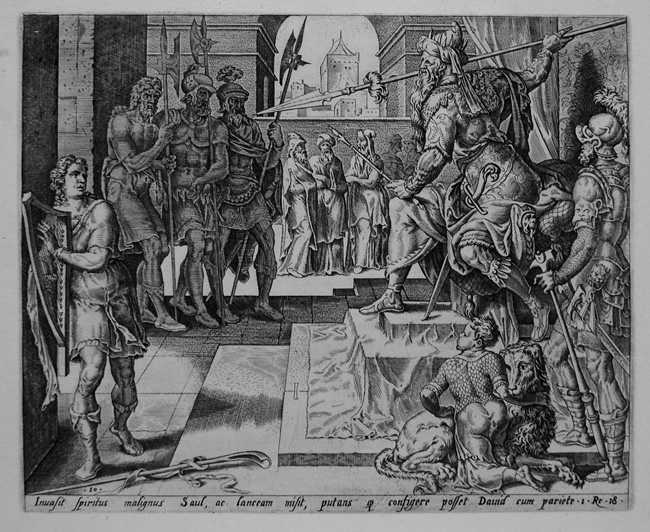
Maerten van Heemskerck (Antwerp, 1498-1574), after, Saul casts a javelin at David (New Holl. 103 iii/iv). Plate 10 of a series of 10 engravings after Heemskerck's drawing, which is preserved in the Louvre and dated 1556. Originally published by Hieronymous Cock in 1556. After the death of his widow (c. 1601), it was published by Theodore Galle and than his brother, Johannes Galle. The final state was published, after some re-engraving, by Claes Jansz. Visscher in 1646. A rich impression printed on antique laid paper with large margins outside the platemark. The moment presented here derives from Samuel 18: "And the day after, the evil spirit from God came upon Saul, and he prophesied in the midst of his house. And David played with his hand as at other times. And Saul held a spear in his hand, And threw it, thinking to nail David to the wall: and David stept aside out of his presence twice. And Saul feared David, because the Lord was with him, and was departed from Saul himself. Therefore Saul removed him from him, and made him a captain over a thousand men, and he went out and came in before the people. And David behaved wisely in all his ways, and the Lord was with him." Image size: 206x251mm. Price: Please call or email for current pricing information.
In a sense, the story told here is not simply a reminder of a passage of Biblical history, but a story of cause and effect. Saul's fear of losing the support of the people is the cause by which he loses the love of the Lord. As Samuel tells him, "Thou . . . hast not kept the commandments of the Lord thy God, which he commanded thee. And if thou hadst not done thus, the Lord would now have established thy kingdom over Israel for ever: But thy kingdom shall not continue. The Lord hath sought him a man according to his own heart: and him hath the Lord commanded to be prince over his people, because thou hast not observed that which the Lord commanded" (Samuel 13). Saul pleads that he had to disobey the Lord's commands to satisfy the people, and is rebuked again: "And Samuel said: 'Doth the Lord desire holocausts and victims, and not rather that the voice of the Lord should be obeyed? For obedience is better than sacrifices: and to hearken rather than to offer the fat or rams. Because it is like the sin of witchcraft, to rebel: and like the crime of idolatry, to refuse to obey. Forasmuch, therefore, as thou hast rejected the word of the Lord, the Lord hath also rejected thee from being king.' And Saul said to Samuel: 'I have sinned, because I have transgressed the commandment of the Lord, and thy words, fearing the people, and obeying their voice' " (Samuel 13). David, on the other hand, has faith that God will do what is necessary to save his people by any means, even the hand of a shepherd boy, so long as that shepherd is motivated by love of God: " 'I will go now, and take away the reproach of the people: for who is this uncircumcised Philistine, who hath dared to curse the army of the living God?' And David said: 'The Lord who delivered me out of the paw of the lion, and out of the paw of the bear, he will deliver me out of the hand of this Philistine.' And Saul said to David: 'Go, and the Lord be with thee' " (Samuel 17). When Goliath, secure in his giant's might, mocks David's weakness and lack of military might or physical power, David's reply stresses the source of true strength: "Thou comest to me with a sword, and with a spear, and with a shield: but I come to thee in the name of the Lord of hosts, the God of the armies of Israel, which thou hast defied this day, and the Lord will deliver thee into my hand, and I will slay thee, and take away thy head from thee: and I will give the carcasses of the army of the Philistines this day to the birds of the air, and to the beasts of the earth: that all the earth may know that there is a God in Israel. And all this assembly shall know that the Lord saveth not with sword and spear: for it is his battle, and he will deliver you into our hands" (Samuel 17). The visual narrative, then, serves not just to delight the eye (though it certainly does that), but to remind us of the meaning of the biblical narrative it presents, to differentiate the story of those who think they must act on their own to save themselves from that of those who have faith that their God will save them.
The Renaissance, especially in the north, was fond of the classical saying that poetry was a "speaking picture" and pictures were "mute poetry." In a series of prints like this one, it seems to me that there is an attempt to join the two, to offer speech to the visual and sight to the word.
Spaightwood Galleries, Inc.
To purchase, call us at 1-800-809-3343 (1-508-529-2511 in Upton MA & vicinity) or send an email to spaightwood@gmail.com.
We accept AmericanExpress, DiscoverCard, MasterCard, and Visa.
We also accept wire transfers and paypal.
For directions and visiting information, please call. We are, of course, always available over the web and by telephone (see above for contact information). Click the following for links to past shows and artists. For a visual tour of the gallery, please click here. For information about Andy Weiner and Sonja Hansard-Weiner, please click here. For a list of special offers currently available, see Specials.
All works are sold with an unconditional guarantee of authenticity (as described in our website listing).
Copyright 2004-2017, Spaightwood Galleries, Inc.
Go back to the top of this page.
Visiting hours: Saturday 10:00 am to 5:00 pm and Sunday noon to 6:00 pm and other times by arrangement.
Please call to confirm your visit. Browsers and guests are welcome.









